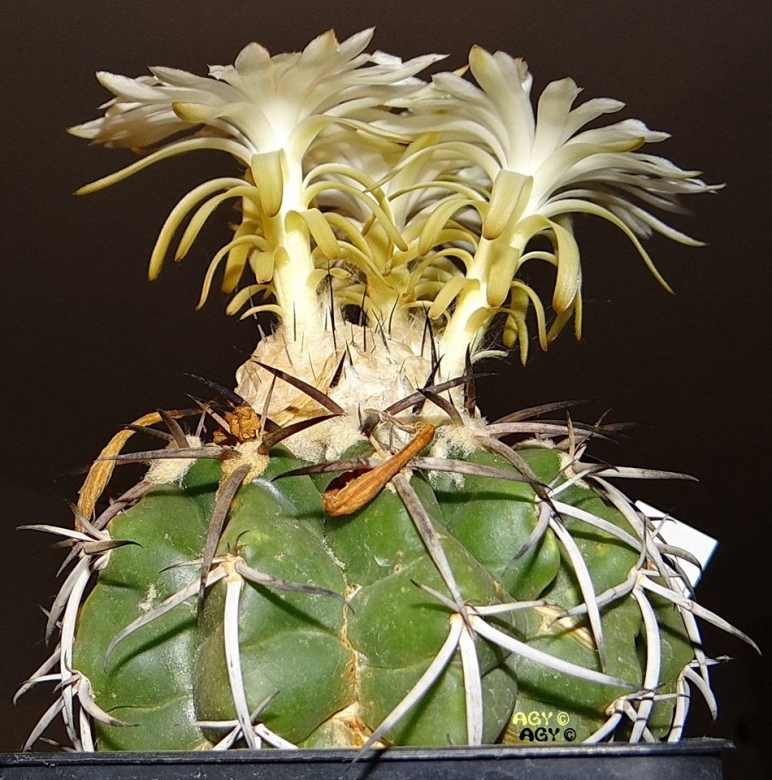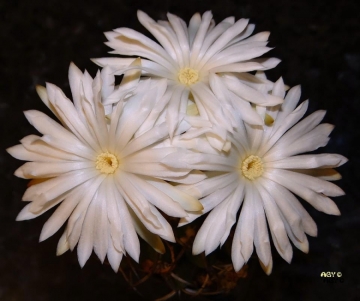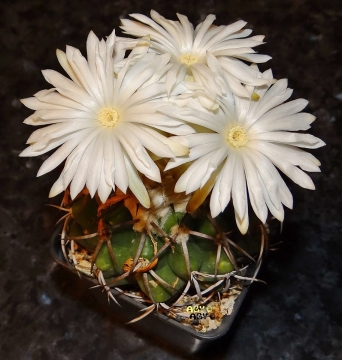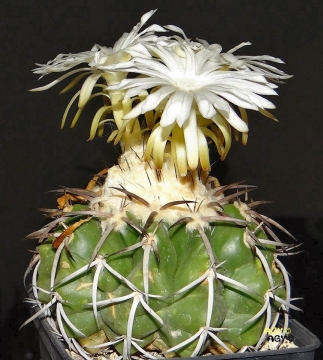Accepted Scientific Name: Discocactus placentiformis (Lehm.) K.Schum.
Nat. Pflanzenfam. Nachtr. [Engler & Prantl] iii. 6 a. (1894) 190.

Discocactus pulvinicapitatus Photo by: Agócs György
At Rebutialand cactus collection Demjén, Hungary.
Origin and Habitat: Central part of the state of Minas Gerais, west of the central massif Espinhaço Mountains, and Rio Jequitai to the east of the Serra do Cabral, Brazil.
Altitude range: 600-650 metres above sea level.
Habitat and ecology: Discocactus pulvinicapitatusSN|1435]]SN|1435]] grows among the rocks in the same area of Uebelmannia pectiniferaSN|14312]]SN|14312]] ssp. horrida. Field numbers HU425, HU461.
Synonyms:
See all synonyms of Discocactus placentiformis
back
Accepted name in llifle Database:Discocactus placentiformis (Lehm.) K.Schum.Nat. Pflanzenfam. Nachtr. [Engler & Prantl] iii. 6 a. (1894) 190.Synonymy: 26
back
Description: Discocactus pulvinicapitatusSN|1430]]SN|1435]] is a solitary flattened cactus that forms a creamy-white to greyish cephalium at maturity and blooms on warm summer nights. It is very close, both morphological and geographically, to Discocactus latispinusSN|1435]]SN|1444]] in form and colour of the spines, but differs from the latter especially its larger size and larger cephalium. The names Discocactus pulvinicapitatusSN|1444]]SN|1435]] is not accepted by many botanists that treat it as synonym Discocactus placentiformisSN|1435]]SN|1430]], but it still has a value for a collector because they identify plants with particular characters.
Roots: Consisting of 2-3 woody, long, main roots, branched distally in a network of thin fibrous roots.
Stem: Always single, flatted globular to globular, to 24(-35) cm in diameter, 7-8(-15) cm high (without Cephalium), greenish to green. The seedlings in the first two years, are purple.
Ribs: Vertical, 15-20 (rarely up to 32), 1-3 cm tall, 3,5-4(-5) cm wide at the base, rounded, sometimes with a constriction between the areoles so that the groove between the ribs appears to be wavy.
Areoles: Approx 5-8(-12) per rib (in plants with cephalium), slightly sunken in the tubercles, round to oval (8-)10-12(-13) mm long, (4-)8-7(-9) mm wide, 2-3 cm apart, at first with a creamy or grey-white tomentum, later naked and black.
Spines: Black-grey or black, turning a dark-grey as they age, roundish to somewhat flattened in older specimens.
Radial spines: 3-5 (rarely to 10), slightly curved inwards. The lowest one 3,5-4 cm long and 4 mm thick, the lateral pair directed obliquely downwards, up to 3 cm long and 3 mm thick at the base, and a second pair (if present) directed obliquely upward up to 2 cm long and 1,5 mm thick. Sometimes 1-3(-4) small spines (ca. 5 mm) pointing upwards, appears on the top of the areola.
Central spine. Usually absent, occasionally in older specimens 1, up to 2 cm long and only near the cephalium. Plants with a central spine are very rare.
Cephalium: Cylindrical, 7-13 across at the base, up to 9 cm tall, with creamy-white to greyish woolly hairs and, reddish to black black bristle protruding to 2,5-3(-5) cm above the wool.
Flowers: Buds lemon-yellow to white. Flowers nocturnal, funnel shaped up to 60 mm long and 40 mm wide. Pericacarpel 13 mm long, 5 mm wide nacked, white. Receptacle tubular up to 40-50 mm long, about 7-10 mm in breadth, with small lanceolate scales up to 4 mm long, 1-2 mm in width, yellowish, very pulpy, especially lower scales. Perianth segments in 3-4 whorls, inner ones lanceolate to 27 mm long and 4-7 mm broad, leathery, thin, white and the margin entire, outer perianth segments, lanceolate or spatulate to 25-33 mm long, 3 mm wide fleshy white, sometimes with a yellowish vein, and yellowish, especially on the lower side. Nectar camber tubular, 13-20 mm long, 2-7 mm across. Primary filaments variable in lengths from flower to flower from 2 to 7 mm long. Secondary stamens about 2.5-4 mm long in 10-14 whorls; anthers pale yellowish to golden yellow 1 mm long, 0.8 mm wide. Style creamy-white, about 20-30 mm long and 1 mm thick, stigma lobes 4-5, less than 4 mm in length, tapered upwards, slightly spreading white. The position of the stigma is at the primary stamens. The flowers are fragrant.
Fruit: White, 2 cm long and 1 cm wide.
Seeds: Helmet-shaped, about 1.5-2 mm long and 1.5-1.9 mm wide, brilliant-black, more thin towards hilum, with unevenly distributed papilliform tubercles.
Subspecies, varieties, forms and cultivars of plants belonging to the Discocactus placentiformis group
 Discocactus crystallophilus Diers & Esteves: has (3)5-7 brown-reddish to pale grey spines, lateral to 2 cm long, lowermost one to 3 cm long. Uppermost about 5 mm long. Distribution: Minas Gerais.
Discocactus crystallophilus Diers & Esteves: has (3)5-7 brown-reddish to pale grey spines, lateral to 2 cm long, lowermost one to 3 cm long. Uppermost about 5 mm long. Distribution: Minas Gerais.  Discocactus insignis Pfeiff.: has 5 to 7 spines of which the lowest one more long and recurved backwards to the plant. Distribution: neighbourhood of Grao Mogol, Minas Gerais, Brazil.
Discocactus insignis Pfeiff.: has 5 to 7 spines of which the lowest one more long and recurved backwards to the plant. Distribution: neighbourhood of Grao Mogol, Minas Gerais, Brazil. Discocactus latispinus Buining ex Bredero ex J.Theun.: has 5 spines of which the lowest one more long and characteristically flattened. distribution: Joaquim Felicio and adjacent areas, Minas Gerais.
Discocactus latispinus Buining ex Bredero ex J.Theun.: has 5 spines of which the lowest one more long and characteristically flattened. distribution: Joaquim Felicio and adjacent areas, Minas Gerais. Discocactus multicolorispinus P.J.Braun & Bredero: spines mostly amber like, but variable in colouration (multicolored) hence the name. Distribution: Serra do Espinhaco in Minas Gerais. Brasil.
Discocactus multicolorispinus P.J.Braun & Bredero: spines mostly amber like, but variable in colouration (multicolored) hence the name. Distribution: Serra do Espinhaco in Minas Gerais. Brasil. Discocactus placentiformis (Lehm.) K.Schum.: is a small flattish globular cactus, with woolly cephalium. It is one of the most widely distributed and variable species. Distribution: whidespread in Minas Gerais.
Discocactus placentiformis (Lehm.) K.Schum.: is a small flattish globular cactus, with woolly cephalium. It is one of the most widely distributed and variable species. Distribution: whidespread in Minas Gerais. Discocactus placentiformis var. minor-horridulus n.n.: has smaller stems, with 5(-7) spines of which the lowest one more long and flattened. Flower often pink in the exterior. Distribution: Diamantina, Minas Gerais, Brazil.
Discocactus placentiformis var. minor-horridulus n.n.: has smaller stems, with 5(-7) spines of which the lowest one more long and flattened. Flower often pink in the exterior. Distribution: Diamantina, Minas Gerais, Brazil. Discocactus pulvinicapitatus Buining & Bredero: is very similar to Discocactus latispinus, but is larger size and has a larger cephalium. Distribution: Central part of Minas Gerais, Brazil.
Discocactus pulvinicapitatus Buining & Bredero: is very similar to Discocactus latispinus, but is larger size and has a larger cephalium. Distribution: Central part of Minas Gerais, Brazil. Discocactus tricornis Monv. ex Pfeiff.: has 3 radial spines pointing downward, occasionally accompanied by 2-3 very short spines pointing upward. (same as Discocactus alteolens?). Distribution. Eastern central Brazil.
Discocactus tricornis Monv. ex Pfeiff.: has 3 radial spines pointing downward, occasionally accompanied by 2-3 very short spines pointing upward. (same as Discocactus alteolens?). Distribution. Eastern central Brazil.
Bibliography: Major references and further lectures
1) KuaS, 1981, H. 11, S. 249-253.
2) KuaS, 1982, H. 7, S. 146-149.
3) Buining, A.F.H. "Die Gattung Discocactus Preiffer." Venlo, O.J. 1980 page page 100
 At Rebutialand cactus collection Demjén, Hungary. Photo by: Agócs György
At Rebutialand cactus collection Demjén, Hungary. Photo by: Agócs György At Rebutialand cactus collection Demjén, Hungary. Photo by: Agócs György
At Rebutialand cactus collection Demjén, Hungary. Photo by: Agócs György At Rebutialand cactus collection Demjén, Hungary. Photo by: Agócs György
At Rebutialand cactus collection Demjén, Hungary. Photo by: Agócs GyörgySend a photo of this plant.The gallery now contains thousands of pictures, however it is possible to do even more. We are, of course, seeking photos of species not yet shown in the gallery but not only that, we are also looking for better pictures than those already present.
Read More... Cultivation and Propagation: Discocactus pulvinicapitatusSN|1435]]SN|1435]] is a difficult plant to cultivate. This species is very sensitive to fungal diseases especially in the first two years, so it isn't a plants for beginners, in fact collectors consider the discocacti to be rarities which requires skilful cultivation. Under glass it appreciates milder winter temperatures and more generous summer watering than most of the other genera of compact cacti. When grown to maturity, however, it possess an exotic look shared by no other cacti, and it generally attract a lot of attention.
Growing rate: It is slow growing.
Soil: It likes very porous standard cactus mix soil. Prefer a low pH compost, avoid substrata rich in limestone; otherwise growth will stop altogether.
Repotting: They generally resent being repotted and can take a long time to establish.
Fertilization: Feed with a high potassium fertilizer in summer.
Exposition: The plant tolerates bright situations but enjoys filtered sunlight or afternoon shade, inside it needs bright light, and some direct sun. Tends to bronze in strong light, which encourages flowering and heavy spine production.
Waterings: Discocacti are very rot prone when kept on their own roots and though they can’t endure long stretches of total dryness, too much water with cool will rot them, as their weak root systems tend to be inefficient at sucking up water from wet soil.
Hardiness: It is rather difficult to grow and frost tender, it can’t stand cold, or even fairly cool temperatures and should be kept at above 15° C if grown on its own roots (8°C if grafted).
Uses: It is an excellent plant for container growing. It always looks good and stays small.
Pests & diseases: It may be attractive to a variety of pests or diseases:
- Red spiders: Red spiders may be effectively rubbed up by watering the plants from above.
- Mealy bugs: Mealy bugs occasionally develop aerial into the new growth among the wool with disfiguring results, but the worst types develop underground on the roots and are invisible except by their effects.
- Scales: Scales are rarely a problem.
- Rot: Rot it is only a minor problem with cacti if the plants are watered and “aired” correctly. If they are not, fungicides won't help all that much.
Propagation: Seeds or grafting. Seeds germinate in 7-14 days at 21-27° C in spring, remove gradually the glass cover as soon the plants will be well rooted (ca 1-2 weeks) and keep ventilated, no full sun for young plants! .Young seedlings are often grafted on a low stock to keep the plant in a good shape.













